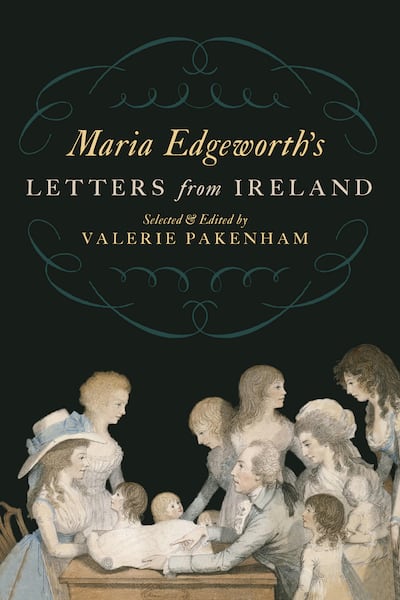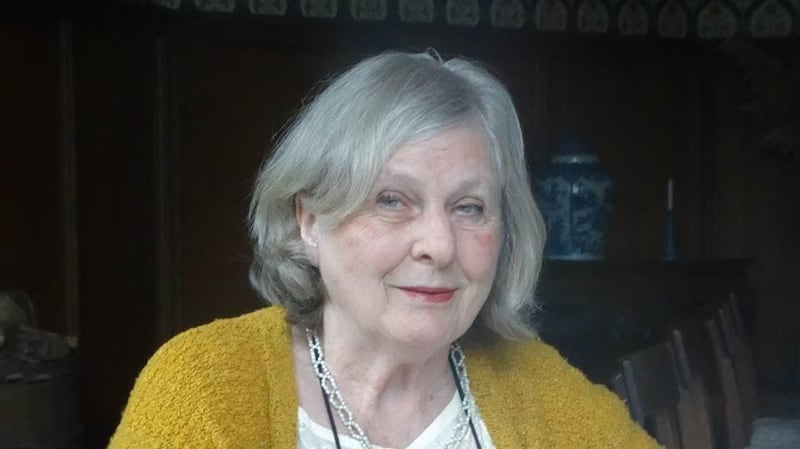
My interest in Maria Edgeworth began when I married in 1964 and came to live in Co Westmeath. The Pakenhams were related to the Edgeworths in nearby Co Longford and there had been frequent visits between the two families, separated by a “vast Serbonian bog”. There was a handsome copy of Richard Lovell Edgeworth’s Memoirs in our library and a complete illustrated set of Maria’s novels upstairs. But even more intriguing were three discreet clothbound volumes without titles: these were A Memoir of Maria Edgeworth by her stepmother Frances Beaufort Edgeworth (who outlived her by nearly 20 years) and largely consisted of extracts from Maria’s own letters. It had been printed privately in 1867. Maria herself had always disapproved strongly of publishing private letters, but after rigorous pruning of anything that might offend or shock the living, her younger sisters had decided to disobey her. Nearly 20 years later, the same extracts were republished by Augustus Hare in his Life and Letters of Maria Edgeworth (now available online). But only in the 1970s were the originals of her private letters made accessible to readers by her great great niece, Christina Colvin, and deposited partly in the National Library in Dublin, and partly in the Bodleian Library in Oxford.
In the late 1990s, my daughter embarked on a composite biography of the Pakenhams of Maria’s generation, including two generals and Kitty Pakenham, who had married (unhappily) the Duke of Wellington. Her research included photocopying many of Maria’s unpublished letters and I was struck immediately by how extraordinarily vivid they were. Unlike the sanitised extracts in her stepmother’s Memoir and Augustus Hare, these were funny, irreverent and full of gossip, both local and from the wider world.
After further investigation I discovered that though Christina Colvin had edited two superb volumes of Maria Edgeworth’s letters from England and from France and Switzerland no one had attempted a new selection from her letters from Ireland, the place where she lived nearly all her adult life and always considered her beloved home. She had been brought to Edgeworthstown by her father from a London boarding school aged 14, and was to die there aged 83 in 1849.

So I set off armed with her stepmother’s Memoir to check out Maria’s manuscript letters in the National Library in Dublin. It immediately became clear there was plenty of hitherto unpublished material. The first treasure trove was a file of Maria’s teenage letters, written to an English school friend, Fanny Robinson (later to marry a rich banker, Charles Hoare.) Prim and serious in tone, these recorded Maria’s first attempts at writing a novel, (inspired by Fanny Burney’s Evelina) and her first impressions of Ireland (much influenced by reading Arthur Young.) She also reported to Fanny the state of Irish politics: “What would you think of a civil war – Upon my word there is danger... .” 1783 saw the climax of the Volunteers’ “loyal” demonstrations on College Green and the demands (highly contradictory) for an independent Irish parliament. Maria’s father, acting as Lord Charlemont’s aide de camp, clearly brought home thrilling first-hand reports.
From these, I moved on to the main file of Edgeworth letters, running from the 1770s until the end of 1817. Out of interest I read through nearly all of them. Here was Maria’s first letter, dutifully written aged 7 from an English boarding school in careful copperplate, and letters from her father and her first stepmother, Honora Sneyd – most of them chillingly lacking in affection to modern ears. Maria’s next letters date from the late 1780s when Richard Lovell Edgeworth had married Honora’s sister, Elizabeth, a far kinder stepmother. Maria’s favourite correspondents, however, were her Aunt Ruxton, a highly sociable lady who lived outside Navan, and Aunt Ruxton’s daughter, Sophy who was to become her confidante in matters of the heart.
Her letters to them are clearly written to entertain and also to hone her storytelling skills: they usually begin with a humorous anecdote, and then go on to books and news
Her letters to them are clearly written to entertain and also to hone her storytelling skills: they usually begin with a humorous anecdote, and then go on to books and news. Maria was a voracious reader and after dinner all the family would sit around in the library reading aloud from the latest books sent from Dublin, usually history or memoirs, often in French. Maria’s news in the 1790s includes alarming reports of attacks by Defenders, or Whiteboys. Ireland was now seething with secret societies, provoked by rising rural distress, and fanned by revolutionary ideas from France. And in 1798 the Edgeworths found themselves in the direct path of a French army who had just defeated the local militia in the so-called Races of Castlebar.
From 1800 on until 1817 politics make little appearance in her letters; the Act of Union had abolished the Irish Parliament and her adored father was mostly at home. After the huge success of Castle Rackrent (1800) Maria, with his encouragement, was turning out a stream of novels and short stories, or as she preferred to call them “Moral Tales”. Her letters at this period are a goldmine for students of Irish or English fiction. By 1812, she was probably the most successful novelist of her time, (she earned a £2,000 advance for her longest novel, Patronage).
But just as interesting to me was the continuing family story – her growing affection for her third and last stepmother, Frances Beaufort (two years younger than herself) and the latest batch of Edgeworth children, six in all. Her father and Frances consciously treated her as a co-parent, probably to make up for the children she would now never have. (She had received one proposal aged 34 while in Paris from a Swedish diplomat, but turned him down, unable to bear the thought of living so far from home). Her letters also report the long drawn-out war with Napoleon. She had glimpsed him briefly in Paris in 1802, a romantic figure on a white horse, but the peace of Amiens had broken down soon after and her half-brother, Lovell, had been caught on his way back through France to be held as a prisoner of war with tragic consequences.

The second collection of Edgeworth family letters, deposited in the Bodleian, tumed out to be vastly larger. When I first began to read through them, they had been rehoused temporarily in a gloomy basement underneath the Science Library beside to the Pitt Rivers Museum. I used to curse the extra quarter of a mile walk from the bus stop in Oxford High Street – and the lack of somewhere nearby to eat. (In fact I quickly discovered The Eagle and Child where Tolkien and CS Lewis had once regularly met for lunch).
I really think that if my thoughts and feelings were shut up within me, I should burst in a week – like a steam engine without a snifting clack, now called by its grander name of a safety valve
The Bodleian collection has Maria’s family letters from 1818 until her death in 1849. As most of her novels were written earlier, these had hitherto attracted little attention from literary scholars. But to me they were even more exciting. Maria’s father had died in June 1817, and released from the discipline of acting as his “literary partner”, she wrote even more and longer letters than before. Some of them run to well over 20 closely written pages, and have necessitated drastic pruning on my part. “I really think that if my thoughts and feelings were shut up within me,” Maria wrote to her aunt in 1821, “I should burst in a week – like a steam engine without a snifting clack, now called by its grander name of a safety valve.”
The Edgeworth estate had meanwhile passed mainly to her eldest brother, Lovell, who had finally reached home in 1814 after 12 years’ detention in France. Kind and idealistic, he had set up a model school in Edgeworthstown, designed to bridge sectarian divides. But he had also become a secret alcoholic and late in 1825, he confessed to having run up enormous debts – nearly £3,000,000 in today’s money.
It fell to Maria to rescue the estate; and she rose magnificently to the challenge, persuading various family members to lend their money to pay off the most urgent debtors, then scraping and saving where she could. Years of benevolent landlordship also paid off: many tenants offered their rents in advance. By the early 1830s the estate was solvent again, though the unfortunate Lovell had been banished to lodgings in Liverpool and his model school was closed down.
It is fascinating to see Maria's metamorphosis from celebrated author to practical estate manager; her letters become full of repairing roads and cottages, digging drains
It is fascinating to see Maria’s metamorphosis from celebrated author to practical estate manager; her letters become full of repairing roads and cottages, digging out drains, checking out the correct ration of mangelwurzels for a cow. Most of which she undertook with huge enjoyment – and affection for the local people she worked with
After her father’s death, she completed only one novel, Helen (published in 1834). It was set in England. “It is impossible to draw Ireland as she is at present in any book of fiction,” she wrote to her brother in India, “Party passions (are) too violent to bear to see...”. Her letters report the electoral triumphs of O’Connell from the 1830s; Catholic tenants, as she saw it, being “driven like beasts” to vote against their landlords. O’Connell died just at the onset of the Great Famine. Maria, aged 80, roused herself to beg and organise local relief with her beloved stepmother and even now hoped that “the cry against Irish landlords” would be put down by “their humanity and active exertions during the distress”. How mistaken she was.
Much of Maria's life was spent cheering and binding together her huge family by a mixture of humour, extraordinary tact and affection. That is the story I hope this selection of her letters from Ireland will tell. They will also provide, I hope, a window onto nearly 70 years of Irish history – from the heady days of the Volunteers and Grattan's parliament in the 1780s, through the Rising of 1798, to the struggle for Catholic Emancipation and the rise of O'Connell, and finally to the Great Hunger, and its immediate aftermath.
Valerie Pakenham is the editor of Maria Edgeworth's Letters From Ireland published by Lilliput Press, which will be launched in the Royal Irish Academy on the evening of November 22nd, 2017











